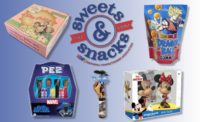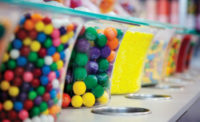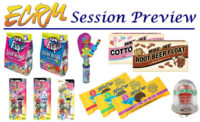Novelty candy: Tapping in to trendy
Guessing right on what will be popular -- and doing so often -- drives novelty sales.

The novelty candy category has that name for a reason. Manufacturers must keep tabs on what's new -- from flavor and ingredient trends to technology, and in many cases, the hottest movies and shows to come down the pike.

The novelty candy category has that name for a reason. Manufacturers must keep tabs on what's new -- from flavor and ingredient trends to technology, and in many cases, the hottest movies and shows to come down the pike.

The novelty candy category has that name for a reason. Manufacturers must keep tabs on what's new -- from flavor and ingredient trends to technology, and in many cases, the hottest movies and shows to come down the pike.

The novelty candy category has that name for a reason. Manufacturers must keep tabs on what's new -- from flavor and ingredient trends to technology, and in many cases, the hottest movies and shows to come down the pike.

The novelty candy category has that name for a reason. Manufacturers must keep tabs on what's new -- from flavor and ingredient trends to technology, and in many cases, the hottest movies and shows to come down the pike.

The novelty candy category has that name for a reason. Manufacturers must keep tabs on what's new -- from flavor and ingredient trends to technology, and in many cases, the hottest movies and shows to come down the pike.






The novelty candy category has that name for a reason.
Manufacturers must keep tabs on what’s new — from flavor and ingredient trends to technology, and in many cases, the hottest movies and shows to come down the pike.
Guessing correctly spells success for both manufacturers and retail buyers, says Rob Auerbach, president of Louisville, Ky.-based CandyRific.
“A good buyer is always going to be looking at things people come to the store to buy — you’re always going to have the basics — but to have a vital, thriving set, you have also got to be thinking of what’s happening in the consumer’s world,” he says.
That philosophy seems to work. The non-chocolate novelty candy market almost broke $678 million in the 52 weeks ending Nov. 27, 2016, according to IRI, a Chicago-based research firm. Just over 386 million units were purchased during that time period, and that’s down 14 percent from a year ago.
Meanwhile, the smaller chocolate novelty market pulled in $5.03 million over the year ending Nov. 27, representing a 5 percent increase. Unit sales virtually remained flat at 1.13 million.
Nonetheless, novelty candy has the ability to inspire emotional connections and impulse purchases, which means it can be offered at a higher price point without much pushback from the consumer, Auerbach says. And that’s important, he adds, since producing novelties with lights, batteries and sound requires more overhead.
“The consumer is totally OK with it because when it connects — whether it’s seasonal, whether it’s Super Bowl, whether it’s a movie they just saw, a brand that they like — when you as a manufacturer, retailer or retail buyer hit the emotional sweet spot of the purchase decision-making process, the retail price point is not a huge factor,” Auerbach says.
That’s where licensing comes in. Auerbach says mega movie franchises with multiple installments and wide appeal have served CandyRific well. He pointed to Disney’s Star Wars saga, which had releases in 2015 with “Episode VII: The Force Awakens” and in 2016 with “Rogue One.” “Episode VIII: The Last Jedi” is slated for late 2017.
To complement the films, CandyRific developed a collection of its signature character fans, talkers, spin pops and — of course — lightsabers, all retailing at $4.99. The films’ popularity provided the magic touch, with the CandyRifiic’s Star Wars items earning four of the top five chocolate novelty candy brands over the year ending Nov. 27, IRI data shows.
Marvel’s Avengers properties, as well as Dreamworks’ Trolls and Universal’s “Despicable Me” and “Minions” films, have offered similar opportunities, Auerbach added.
“It drives them to look for products that connect to the event,” he says.
While CandyRific deals mostly in M&M’S and pressed dextrose candy, Auerbach noted the company is evaluating ways to enter the better-for-you arena — another trend touching all segments of the confectionery and snack industries.
It’s a theme Atlanta, Ga.-based Innovative Candy Concepts (ICC) knows well. All of its products are sugar-free, which is an asset for candy developed and marketed especially for children, says Armand Hammer, the company’s president and ceo.
“The concept of sugar-free has really changed from the consumer’s standpoint,” Hammer says. “Today, the concept of sugar-free is something that a lot of people are actually looking for.”
Well, it’s something parents seek. “The kids don’t care as long as it tastes good,” and offers a fun experience, Hammer says.
ICC’s Too Tarts line consists of liquid or gel candy in different packaging. For example, the All-Kidz Blend Liquid SuckUps allow children to consume the liquid through a baby bottle, while the All-Kidz Blend Spray Candy allows them to spray it directly onto their tongues. Flavors include Blueberry, Strawberry and Green Apple.
“Interactive(ness) is really important,” Hammer says. “Kids are really smart these days. They know what they like, they know what they want.”
ICC entered the chocolate segment last fall with the development of Melted Chocolate Candy. The chocolate has a pudding-like texture and comes with a spoon, so consumers can eat it directly from a 2-oz. tub. And like the Too Tarts line, it’s sugar-free.
Hammer says ICC was ready to take Melted Chocolate Candy to market last fall, but decided to tweak it after receiving feedback from customers that it was too expensive at $2.99 and was too thin to eat with the spoon.
ICC switched out a 2-oz. jar with the tub, dropping the suggested retail price by a dollar. The company also thickened the candy’s consistency so it mirrors that of a popular chocolate hazelnut spread. Hammer says the retooled product was expected to launch this month with three flavors: Creamy Chocolate, Chocolate Caramel and Chocolate Caramel.
ICC isn’t the only company to experiment with textures and flavors. Bazooka Candy Brands has found a boon in its Juicy Drop line, which includes chewing gum, taffy, gummies and the Juicy Drop pop.
The Juicy Drop gum, which also won Candy Industry’s 2016 Buyer’s Choice Award for Best New Novelty, mixes sour and sweet flavors, as well as a traditional gum texture with a gel candy “flavor booster.”
“Juicy Drop is the only brand that allows consumers to control the combination of sweet and sour tastes in every bite, which has made it more and more popular every year,” says Nicole Rivera, Bazooka marketing and innovation director in a news release. “Juicy Drop has a proven track record of innovation within the non-chocolate category.”
No matter the brand, Auerbach says he hopes retailers will continue to see novelty candy as a part of a well-rounded candy set and not a “filler” for remaining shelf space.
“When you mix novelty confectionery offerings with traffic, it’s successful,” he says.
Looking for a reprint of this article?
From high-res PDFs to custom plaques, order your copy today!













